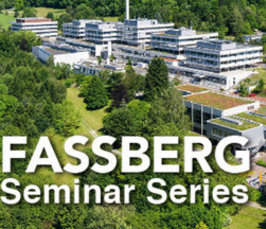Faßberg Seminar Series: Phase separation at the nerve terminal
Faßberg Seminar Series
- Datum: 05.09.2018
- Uhrzeit: 11:00 - 12:30
- Vortragende(r): Dr. Dragomir Milovanovic
- The De Camilli Lab, Yale School of Medicine, New Haven, CT, USA
- Ort: Max-Planck-Institut für biophysikalische Chemie (MPIBPC)
- Raum: Ludwig Prandtl Hall
- Gastgeber: Prof. Dr. Reinhard Jahn
- Kontakt: office.jahn@mpibpc.mpg.de

Phase Separation at the Nerve Terminal
Dragomir Milovanovic
Departments of Neuroscience and Cell Biology, Program in Cellular Neuroscience,
Neurodegeneration and Repair, Kavli Institute for Neuroscience, Howard Hughes Medical
Institute, Yale University School of Medicine, New Haven, CT, USA
Neuronal transmission relies on the sustained release of neurotransmitters from synaptic vesicles
(SVs) upon depolarization of neurons. Nerve terminals contain hundreds of SVs that form tight
clusters. Despite being held together, vesicles are highly mobile within these clusters, so that they
can be randomly recruited to the surface of the cell to release their content upon activation of the
neuron. How this compact, yet the dynamic organization is achieved remained elusive. Several
studies in the past decade showed that macromolecules may assemble into distinct liquid
compartments not-limited by a membrane, a process known as liquid-liquid phase separation.
Recently we have discussed (Milovanovic and De Camilli, Neuron, 2017) how several features of
SV clusters suggest that they may be part of a distinct liquid phase in the cytosol. For example,
SV clusters have sharp boundaries, exclude other organelles, vesicles in these clusters are mobile,
and SVs can be exchanged with vesicles outside the cluster. Thus, SV cluster may represent a
distinct liquid phase in which one component of the phase are synaptic vesicles and the other
component are proteins of the intervening matrix.
In our latest study, we show that synapsin 1, a highly abundant synaptic protein, forms a distinct
liquid phase in an aqueous environment. Synapsin 1 exchanges readily between the phase where
is enriched and the surrounding medium. Additional synapsin 1 binding scaffolding proteins
further modulate this phase but are not necessary for its formation. Importantly, synapsin 1 can
capture small lipid vesicles into its phase. The phase of synapsin 1 rapidly disassembles upon
phosphorylation by CaMKII, mimicking the dispersion of synapsin 1 that occurs at presynaptic
boutons upon simulation. Thus, a minimal system of synapsin (with or without its binding partners)
may sequester lipid vesicles, forming a distinct liquid phase.
Referenced articles:
Milovanovic D and De Camilli P. Synaptic vesicle clusters at synapses: a distinct liquid phase?
(2017) Neuron, 93: 995
Milovanovic D, Wu Y, Bian X, De Camilli P. A liquid phase of synapsin and lipid vesicles.
Science in press DOI: 10.1126/science.aat5671
Dragomir Milovanovic
Departments of Neuroscience and Cell Biology, Program in Cellular Neuroscience,
Neurodegeneration and Repair, Kavli Institute for Neuroscience, Howard Hughes Medical
Institute, Yale University School of Medicine, New Haven, CT, USA
Neuronal transmission relies on the sustained release of neurotransmitters from synaptic vesicles
(SVs) upon depolarization of neurons. Nerve terminals contain hundreds of SVs that form tight
clusters. Despite being held together, vesicles are highly mobile within these clusters, so that they
can be randomly recruited to the surface of the cell to release their content upon activation of the
neuron. How this compact, yet the dynamic organization is achieved remained elusive. Several
studies in the past decade showed that macromolecules may assemble into distinct liquid
compartments not-limited by a membrane, a process known as liquid-liquid phase separation.
Recently we have discussed (Milovanovic and De Camilli, Neuron, 2017) how several features of
SV clusters suggest that they may be part of a distinct liquid phase in the cytosol. For example,
SV clusters have sharp boundaries, exclude other organelles, vesicles in these clusters are mobile,
and SVs can be exchanged with vesicles outside the cluster. Thus, SV cluster may represent a
distinct liquid phase in which one component of the phase are synaptic vesicles and the other
component are proteins of the intervening matrix.
In our latest study, we show that synapsin 1, a highly abundant synaptic protein, forms a distinct
liquid phase in an aqueous environment. Synapsin 1 exchanges readily between the phase where
is enriched and the surrounding medium. Additional synapsin 1 binding scaffolding proteins
further modulate this phase but are not necessary for its formation. Importantly, synapsin 1 can
capture small lipid vesicles into its phase. The phase of synapsin 1 rapidly disassembles upon
phosphorylation by CaMKII, mimicking the dispersion of synapsin 1 that occurs at presynaptic
boutons upon simulation. Thus, a minimal system of synapsin (with or without its binding partners)
may sequester lipid vesicles, forming a distinct liquid phase.
Referenced articles:
Milovanovic D and De Camilli P. Synaptic vesicle clusters at synapses: a distinct liquid phase?
(2017) Neuron, 93: 995
Milovanovic D, Wu Y, Bian X, De Camilli P. A liquid phase of synapsin and lipid vesicles.
Science in press DOI: 10.1126/science.aat5671